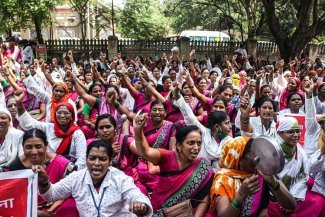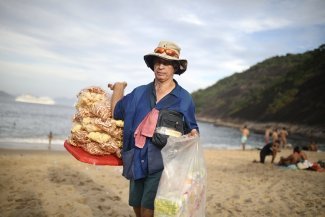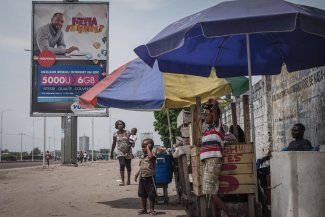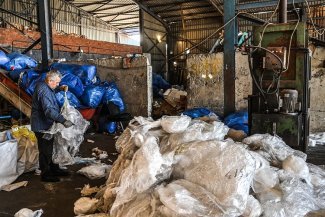
There are 652,500 international students in Australia, many of whom have been desperate for support from the federal government during the coronavirus crisis.
When Colombian Andrés Puerto was choosing where to do his master’s degree, he considered universities in Canada and New Zealand, but in the end Australia won him over. “It’s a very beautiful country and a land with lots of opportunities so it was the best option,” he says. “It’s a very good country for international students, the people are welcoming.”
But nearly four years into his new life in Sydney, where the 27-year-old has almost completed a business and information systems degree at Torrens University, Puerto finds himself struggling to finish his studies amidst the COVID-19 pandemic. Along with tens of thousands of other foreign students in Australia, he has no income and no access to government assistance.
There are 652,500 international students in Australia, and many work part-time alongside their studies. But those who have lost their jobs because of the crisis are ineligible for federal government wage subsidies or unemployment benefits via the JobKeeper and JobSeeker schemes available to their Australian counterparts.
Although international students do have access to Australia’s healthcare system, mainly through the mandatory purchase of Overseas Student Health Cover, without financial support and social networks, there are fears that some international students are now on the brink of homelessness. Coverage of international students queuing at food banks has been headline news across the nation.
Australia is the fourth most popular country in the world for international students. With education ranking as the country’s third-largest export, the impact of the coronavirus on overseas students in higher education could lose Australia between AU$3 and AU$4.6 billion (approximately US$2 and US$3.1 billion) this year, over 21,000 jobs, and much more in terms of reputation. “I know a lot of students are scared that they can’t sustain themselves,” Puerto tells Equal Times. “When they heard [Prime Minister Scott Morrison], they thought ‘why are they treating us like we aren’t relevant members of society?’” he says, referring to comments made by the leader in early April that students and temporary visa holders should return home if they couldn’t support themselves in Australia.
Having locked down quickly, and with an indefinite international travel ban for non-residents and non-citizens imposed on 19 March, Australia has recorded a relatively small number of coronavirus cases (7,350) and deaths (102). But despite the country’s successful handling of the virus, overseas students are still reeling from the fallout. “So many of them are just waiting for the borders to open so that they can leave,” says Puerto.
“A failure of humanity”
Australia welcomed 750,000 foreign students last year. The majority come from India or China, but in recent years enrolments from Brazil, Colombia, Argentina, and Chile have spiked. “Many [students from Latin America] come here to learn English but also want to continue their higher education,” says Diana Prada, 30, a Colombian living in Sydney and a community organiser with the non-profit Somos21, which promotes collaboration between Australia and Latin America.
Prada, who moved to Sydney five years ago to complete a dual masters of business administration and global project management at Torrens University before securing a job with the non-profit Sydney Alliance, says that the fact that foreign students can work part-time while studying (up to 20 hours a week during term time, with no limit during the holidays) also adds to Australia’s international appeal.
However, with work in industries like hospitality now having dried up, many foreign students are now having great difficulties paying their rent.
Some Australian states like Victoria have announced help such as the International Student Emergency Relief Fund, which provides a one-off payment of up to AU$1,100 (approximately US$750) to students who have lost their income due to the pandemic.
An AU$20 million (US$13.6 million) support package was also announced by the New South Wales (NSW) government, the state most popular with foreign students, weeks into the crisis. While the package was welcomed by the Council of International Students Australia, it was labelled by the state opposition as “long delayed and hopelessly inadequate”. It includes temporary crisis accommodation and legal support, but no cash payments.
NSW Shadow Minister for Innovation, Science and Tertiary Education Clayton Barr MP tells Equal Times that the state government’s response “demonstrates a failure of their humanity. I urge them to show more compassion and understanding of how difficult it is to be stuck in a foreign country with no money and no support from government, relying instead on the pure generosity of community which, while welcome and wonderful, is sporadic and unpredictable”.
Australian Greens senator for NSW Dr Mehreen Faruqi says it is not too late for the government to change its mind and extend income support for these students, or at least establish a proper hardship fund. “International students have been left completely high and dry by the Australian government,” she tells Equal Times.
But a spokesperson for the federal Department of Education, Skills and Employment refutes this claim: “International students can access support initiatives worth more than AU$1.3 billion (approximately US$880 million) provided by the federal government, state and territory governments and universities.”
The spokesperson also notes that students who work part-time and who have been in Australia for longer than a year and find themselves in financial trouble can access their Australian superannuation (company pension plan), and that in critical sectors such as aged care, students are able to work extended hours. States and territories have also imposed a six-month ban on evictions for both residential and commercial tenants during the pandemic, and the federal government is working with community organisations and education providers to ensure that students have access to mental health and welfare programmes.
Solidarity and support from volunteers
While some individual institutions have hardship funds in place, critics point to countries like New Zealand, Canada, the United Kingdom and Ireland, which have offered more support including wage subsidies and free visa extensions. To fill the void in Australia, charities have stepped up. Turbans 4 Australia, a volunteer-run charity founded by an Australian Sikh, are serving free meals and giving food hampers to vulnerable groups across Sydney and Canberra.
MyStay International, which places needy students with local families across Australia at a discounted rate, said that they have received over 1,000 host applications with the “number growing every day”. Founder David Bycroft tells Equal Times: “We’re only seeing the start of the problem right now – it’s going to get a lot worse, and it’s not going to get a lot better until we’re back in full economy again and that’s not for months and months.” Bycroft says that Australia now has “two opportunities”: “One is to limit the number of COVID cases, and second is to make sure the world knows we looked after our international students while they were here.”
Ajay (not his real name) moved to Australia in July 2019 from India to study a master’s in data science at Monash University, which will set him back by AU$80,000 (approximately US$55,000). But after the 25-year-old’s café job was suspended in March, he was left with just AUU$50 (US$35) in his bank account to survive.
Ajay says that the prime minister’s comments about going home felt like rubbing salt into a wound. “Students aren’t after money. We just wanted a warm gesture, for people to say: “You’re a part of our community, we’ll take care of you,’” he says.
On 20 April, Ajay applied for a student hardship grant and received AU$3,000 (approximately US$2000) from his university on 10 May. “I’m thankful for what they did, but by the time I received the money, a lot of damage had already been done.”
With the travel ban still in place, some international students now face being trapped outside the country as the second semester begins in July. “We’re paying five times more than domestic students to receive the same education,” says Flora Zhao, who has just one year of her University of Sydney law degree left, while she is currently stranded back home in China. “But when it comes to a pandemic like this, international students’ rights and benefits are almost completely disregarded.”
Last week, the federal government confirmed that foreign students can return to Australia under a trial which will reportedly be arranged by state and territory governments, with quarantine paid for by universities. Professor Andrew Vann, the vice-chancellor of Charles Sturt University, which has multiple campuses across the country, will be welcoming them back. Vann says that the university has lost AU$80 million (approximately US$55 million) in revenue due to COVID-19, the majority of which is associated with its international programme. “It is critical that universities are able to welcome back international students. Whether studying in our capital cities, or in our regions, the international student cohort brings varied benefits to the communities: diversity, creativity, and a boost to local business and tourism.”









